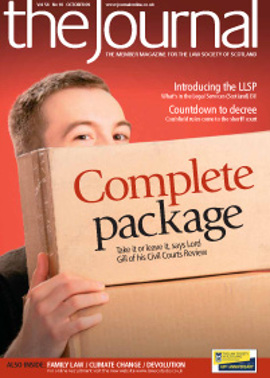Adopting new solutions

The end of September saw a significant milestone. Major changes to adoption law have finally come into force through the Adoption and Children (Scotland) Act 2007. Although the Act received royal assent in January 2007, it was only on 28 September 2009 that most of the changes to the adoption system took effect.
The stated purpose of the Act is to modernise, improve and extend the system of adoption in Scotland. Among the most striking changes to the law is the fact that more people can now adopt a child. Previously, for example, a gay person had to adopt a child as a single person, regardless of the status of his or her relationship. The changes also mean that cohabiting couples are now able to adopt jointly, whereas previously only one half of the couple, as a single person, was permitted to adopt the child.
The law has also changed in relation to step-parent adoption. Beforehand, when a step-parent wished to adopt his or her step-child, both the step-parent and the birth parent had to apply to adopt the child together. The Children (Scotland) Act 1995 changed the law so that a married step-parent could adopt without requiring the birth parent to adopt his or her child also. The new law now permits step-parent adoption even where the step-parent is a civil partner or a cohabitant of the birth parent.
Permanence orders
As well as dealing with adoption, the Act provides a new option for the long term care of children who are not able to return to their birth parents. Local authorities may apply for a permanence order. Permanence orders have the potential to provide stability and security, while also possessing the necessary flexibility to cater for the specific and changing needs of every individual child who cannot live with his or her birth parents.
Stability and security will be provided by virtue of the fact that all permanence orders must contain the mandatory provision which vests in the local authority the responsibility of providing guidance to the child and the right to regulate the child’s residence. The flexibility is possible due to the fact that permanence orders can contain ancillary provisions as the court thinks fit. This allows the court, for example, to specify contact arrangements between the child and any other person. The new Act should also allow important decisions to be taken about a child’s life without unnecessary delay. If appropriate, the permanence order may contain the court’s authority for the child to be adopted at a later stage.
An application for such an order is viewed as the replacement for a freeing application, which is no longer competent under the new Act. The Adoption (Scotland) Act 1978 continues to apply to freeing applications already made but not yet determined. Where a child has been already freed for adoption, the freeing order will continue to have effect until 28 September 2010. The child freed for adoption will then be treated as if he or she is subject to a permanence order with authority to adopt.
True reading?
Another significant effect of the Act is that birth parents who have lost their rights through adoption are now able to apply to the court for an order allowing them to have contact with the adopted child. Section 11 of the Children (Scotland) Act 1995 has been amended so that such applications may be made with leave of the court. However, it appears from a reading of the amended s 11 that birth parents who have lost responsibilities and rights through freeing may apply for any s 11 order (including contact) without leave of the court.
It cannot be stated with certainty how the courts will view this section and they may be reluctant to accept this interpretation of the Act. That said, the Inner House has commented unfavourably on the implications of s 11 for a birth parent whose child is freed for adoption (West Lothian v M 2002 SLT 1155). Certainly, the policy memorandum to the bill stated that s 11 would be amended so that individuals who had lost parental responsibilities and rights through the making of an adoption order, a freeing order or a parental responsibilities order would be able to apply for a contact order.
Altogether, this is definitely a time of significant change in child law in Scotland. The Adoption and Children (Scotland) Act has wide-ranging implications for the legal profession, local authorities, parents and of course children themselves.
Kirsty McGuinness, solicitor, Brodies LLP
In this issue
- The Combined Standard Clauses (2009 edition)
- Preserving a legal inheritance: settlement rights in the "Occupied Palestinian Territories"
- The European Court and the duty to investigate deaths
- Chief Executive's SGM address
- Shelter's online resources
- Musical copyright and contract
- The international swap shop
- Headline fortnight
- The Gill Report? What's not to like?
- Solicitor advocates and conflicts of interest
- Settlement in the West Bank
- Package deal
- RoS = economic value
- Defining the future
- Global leader?
- Dog's chance
- Coulsfield rules OK
- Money and your life
- Experts on the case
- At the hub, 10 years on
- Guardians: don't look to the Fund
- From the Brussels office
- Ask Ash
- Making the most of ABS
- Planning for growth
- The perils of posting
- ARTL: friend or foe?
- Where privacy prevails
- How was it for you?
- Agreeing rescues with creditors
- Adopting new solutions
- Divorce for gender change
- Scottish Solicitors' Discipline Tribunal
- Book reviews
- Website review
- A safe pair of hands tops the bill
- Law out of step






